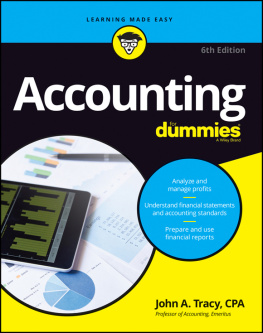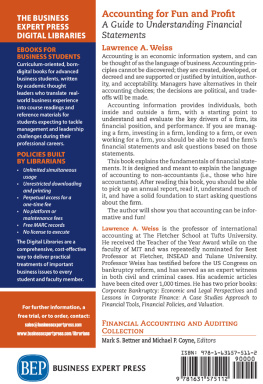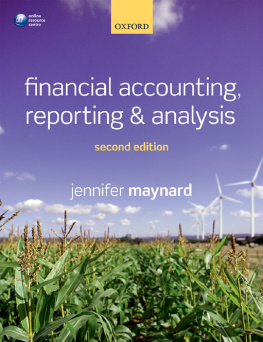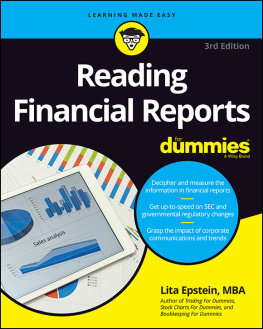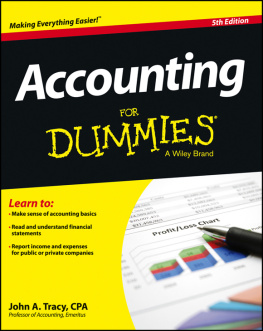CONTENTS

Cover Design: Wiley
Cover Illustration: Wiley
Copyright 2014 by John A. Tracy and Tage C. Tracy All rights reserved.
Published by John Wiley & Sons, Inc., Hoboken, New Jersey.
The Seventh Edition of How to Read a Financial Report: Wringing Vital Signs Out of the Numbers was published by John Wiley & Sons, Inc, in 2009.
Published simultaneously in Canada.
No part of this publication may be reproduced, stored in a retrieval system, or transmitted in any form or by any means, electronic, mechanical, photocopying, recording, scanning, or otherwise, except as permitted under Section 107 or 108 of the 1976 United States Copyright Act, without either the prior written permission of the Publisher, or authorization through payment of the appropriate per-copy fee to the Copyright Clearance Center, Inc., 222 Rosewood Drive, Danvers, MA 01923, (978) 750-8400, fax (978) 646-8600, or on the Web at www.copyright.com . Requests to the Publisher for permission should be addressed to the Permissions Department, John Wiley & Sons, Inc., 111 River Street, Hoboken, NJ 07030, (201) 748-6011, fax (201) 748-6008, or online at http://www.wiley.com/go/permissions .
Limit of Liability/Disclaimer of Warranty: While the publisher and author have used their best efforts in preparing this book, they make no representations or warranties with respect to the accuracy or completeness of the contents of this book and specifically disclaim any implied warranties of merchantability or fitness for a particular purpose. No warranty may be created or extended by sales representatives or written sales materials. The advice and strategies contained herein may not be suitable for your situation. You should consult with a professional where appropriate. Neither the publisher nor author shall be liable for any loss of profit or any other commercial damages, including but not limited to special, incidental, consequential, or other damages.
For general information on our other products and services or for technical support, please contact our Customer Care Department within the United States at (800) 762-2974, outside the United States at (317) 572-3993 or fax (317) 572-4002.
Wiley publishes in a variety of print and electronic formats and by print-on-demand. Some material included with standard print versions of this book may not be included in e-books or in print-on-demand. If this book refers to media such as a CD or DVD that is not included in the version you purchased, you may download this material at http://booksupport.wiley.com . For more information about Wiley products, visit www.wiley.com .
Library of Congress Cataloging-in-Publication Data:
Tracy, John A.
How to read a financial report: wringing vital signs out of the numbers / John A. Tracy, CPA, Tage Tracy. 8th ed.
pages cm
Includes index.
ISBN 978-1-118-73584-8 (pbk.); ISBN 978-1-118-73558-9 (ebk); ISBN 978-1-118-73592-3 (ebk)
1. Financial statements. I. Tracy, Tage C. II. Title.
HF5681.B2T733 2014
657'.3dc23
2013035597
LIST OF EXHIBITS
| Summary of Cash Flows during Year |
| Year-End Balance Sheets |
| Income Statement for Year |
| Statement of Cash Flows for Year |
| Single Step Income Statement |
| Income Statement and Balance Sheet Changes during Year from Profit-Making Activities |
| Connections between the Three Financial Statements |
| Sales Revenue and Accounts Receivable |
| Cost of Goods Sold Expense and Inventory |
| Inventory and Accounts Payable |
| Selling, General, and Administrative Expenses and Accounts Payable |
| Selling, General, and Administrative Expenses and Prepaid Expenses |
| Property, Plant, and Equipment, Depreciation Expense and Accumulated Depreciation |
| Accruing Unpaid Expenses |
| Income Tax Expense and Income Tax Payable |
| Net Income and Retained Earnings, Earnings per Share |
| Cash Flow from Operating (Profit-Making) Activities |
| Direct Method Format for Reporting Cash Flow from Operating Activities in the Statement of Cash Flows |
| Cash Flows from Investing and Financing Activities |
| Cash Flow from Operating (Profit-Making) Activities in Steady-State Scenario |
| Cash Flow from Operating (Profit-Making) Activities in Growth Scenario |
| Cash Flow from Operating (Profit-Making) Activities in Decline Scenario |
| Three Financial Statements and Footnotes |
| External Financial Statements of Business (without Footnotes) |
| External Income Statement for Year |
| Management Profit Report for Year |
| 5% Sales Prices versus 5% Sales Volume Increase |
| EBIT Breakeven Point for Lower Sales Prices and Lower Sales Volume |
PREFACE TO THE EIGHTH EDITION
When I started this book my new co-author on this edition, my son Tage, was entering his senior year of high school. Today he is a successful business and financial consultant in San Diego. Truth be known, he writes better than his old man. So, it is with great personal pleasure and pride that I welcome my son Tage as co-author on this edition. Hes a chip off the old block. In case youre wondering about his name, it is Swedish and Danish in origin.
At the time the first edition was released in 1980, the Dow Jones Industrial Average hovered around 850 (really!). This most-watched stock market index reached 11,700 in early 2000, and then it abruptly plunged, causing a big dent in my retirement savings. The Dow recovered over the following years, but then dropped again. As I write this sentence the Dow is about 15,000. As J. P. Morgan once said, The market will fluctuate. Millions of individuals keep their money in the stock market, and stock investments are a large part of most retirement plans. Knowing how to read a financial report is as important as ever.
This edition catches up with the major changes in financial reporting since the previous edition. At the top of this list is the movement toward different financial reporting standards for private and small businesses. At the same time, the basic architecture of the book remains unchanged. The framework of the book has proved very successful for more than 33 years. Id be a fool to mess with this success formula. My mother did not raise a fool. Cash flows are underscored throughout the book. This cash flow emphasis is the hallmark of the book.
I prepared all the exhibits in the book as Excel worksheets. To request a copy of the workbook file of all the exhibits, please contact me at my e-mail address: . I express my sincere thanks to all of you who have sent compliments about my book. The royalties from sales of the book are nice, but the bouquets from readers are icing on the cake.
Not many books of this ilk make it to the eighth edition. It takes a good working partnership between the author and the publisher. I thank most sincerely the many persons at John Wiley & Sons who have worked with me on the book for more than three decades now. The suggestions on my first draft of the book by Joe Ross, then national training director of Merrill Lynch, were extraordinarily helpful. The continuing support of Debra Englander over the years is very much appreciated. And Id be remiss without mentioning Tula Batanchiev and Judy Howarth, who have been a pleasure to work with on this edition. They have made the new edition much better than if we had been left on our own. Books are the collaboration of good editors and good authors. We had good editors; youll have to be the judge how good the authors are.



